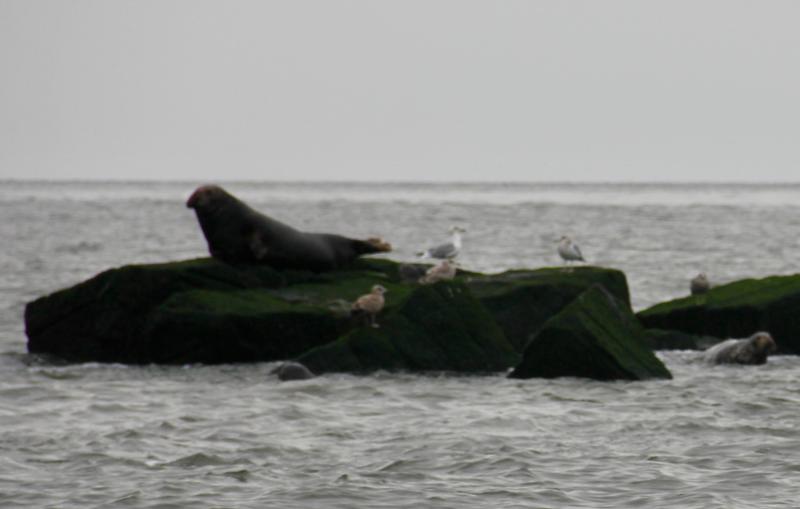More information on possible icebreaker gray seals
Monday morning a week ago. Ralph called early.
“Have you been outside?”
“No.”
“Well, go take a look. It’s raining and sleeting and cold. The boat’s all hooked up and ready to go, but it’s going to be miserable out there.”
Silence for a moment. Brain whirling. Ralph doesn’t call off on a whim. He likes to fish almost as much as he likes to hunt quail over a brace of fine setters. But the quail are gone so now it’s all fishing – even in December.
My younger brother, Raym, was already halfway down from Newark. Didn’t have to work that day. In fact, he doesn’t have to work any more days. He retired just a few days before, after decades as a weed scientist with DuPont. He likes to fish and hunt almost as much as Ralph.
My older brother, Mike, died a few years ago from pancreatic cancer. In his last months, he repeated two pieces of wisdom. First, from Voltaire’s “Candide”: You have to cultivate your garden. Second: Don’t wait.
Raym took the wisdom to heart. He retired so he could spend more time fishing and hunting, and sharing special moments with friends and family. On this Monday morning, driving south to Sussex, juiced on caffeine and loving life, he was cultivating, not waiting.
“Ralph,” I said, “I think this garbage is supposed to ease out of here. Raym’s on his way; let’s dress right and get after it. We’ll see you at the ramp at 7:30.” That’s the only nudge Ralph needed.
Then I stuck my head out the front door to verify what Ralph had told me. Tiny little ice crystals hit my cheeks, as they would for the next couple of hours. But with fresh everything bagels with sausage, egg and cheese in our bellies, I knew our internal furnaces would fire up and we would be fine.
What about the seals?
But that’s not really what I wanted to tell you. I really wanted to say a little more about the seals. Ralph had told me a couple weeks back there were lots of seals out at the icebreakers, in the mouth of the bay, and he planned to run out there first this morning to see if they were still there. Then we would head out along the coast and look for stripers.
He was pretty sure we would see the seals, but wasn’t quite so confident about the stripers.
“If we can find the stripers, we’ll catch them,” he said. “They’re not hard to catch, but finding them is another story.”
He was right on all counts.
We made the icebreakers about 15 minutes after we left the ramp, and immediately saw seals around the broken-down pile of rocks at the west end of the icebreaker series. There were a dozen at least, mostly light gray with spotted faces. Harbor seals I’d say, about the size of Golden Retrievers. I tried to get a few decent photographs, but they were like whack-a-mole. Every time I focused and shot, they were a split second ahead of me, ducking beneath the water.
“Let’s head up along the other stacks and see how many more we see.”
Gray dominated that morning. The sleet, the rain, the water, the sky and the slick rocks – all shades of colorless, unfriendly gray.
Then we saw one seal tucked in and lounging on rocks inside one of the stacks. Cool. At the same time, Raym pointed to a long, dark rock at the top of the same stack.
“I’m not sure that’s a rock.”
Then it moved. Rocks don’t move. It lifted its head and then lifted its tail and turned to gauge how close we were going to get. Then it decided it was time to retreat. It slipped its big, dark-gray, slippery form off its rocky platform and disappeared into the brine.
This creature was a different animal, at least four times as large as the smaller seals out there. We speculated. Walrus, sea lion?
That talk salted our conversation for the next few hours as we put the icebreakers and the outer wall behind us to search for stripers.
No luck. A few gannets here and there teased us, but no big groups of them working the water to indicate a ball of bait and stripers beneath. It wasn’t for lack of trying.
We fished the shoals of Hen and Chickens, skirted buoys in the shipping lanes, explored the three-mile line where federal waters begin – off limits for striper fishing – and made our way southward along that line locals call the fence. We almost made Indian River Inlet before the weather and lack of success turned us around.
There was a time when people hunted the big gray seal that I’m convinced we saw. But they weren’t on our list today. According to brief research on the internet, I determined that gray seals – often trained and seen in circuses – were hunted up until the middle of the 20th century for their oil, meat and skins. Bounties were offered for them by Maine and Massachusetts.
By 1972, when the federal Marine Mammal Protection Act was passed, a count along the Maine coast found only 30 gray seals where many colonies had previously lived, with numbers in the thousands. It’s called extirpation when local populations such as gray seals are hunted to near extinction.
With federal protection, gray seal numbers rebounded. By 2011, the National Marine Fisheries Service counted almost 16,000 gray seals in southeastern Massachusetts coastal waters. The NMFS also speculated that “it is expected that they will establish colonies further south.” Famed writer and naturalist Farley Mowat - ‘Never Cry Wolf’ - once reported that historic breeding colonies of gray seals were found as far south as Cape Hatteras.
Gray seals are big animals. Seven-footers like the one we saw are commonplace and can weigh anywhere from 370 to 680 pounds. Males average about 500 pounds. They can dive as deep as 230 feet or more in search of their prey, which include fish and even the smaller harbor seals. Their average daily feed is about 11 pounds, but they can also go a few days without eating.
So what preys on gray seals? Great white sharks, among other marine predators. A 2009 study determined that thousands of gray seals had taken up residence on or near popular swimming beaches on Cape Cod. Great white sharks are drawn to shore to hunt gray seals. A friend told me that we don’t have to worry about that here. He said the great whites prefer cooler waters. At least a little comfort there.
My research found that gray seals are being seen increasingly in New York and New Jersey waters. After our icy fishing trip, I’m as certain as I can be, without positive proof, that they’ve also made it to Delaware waters.
























































